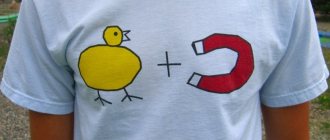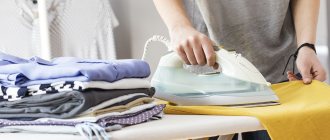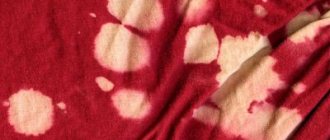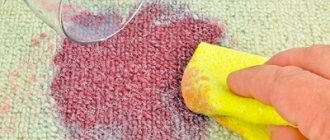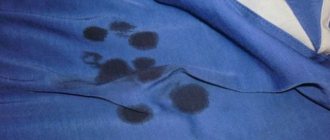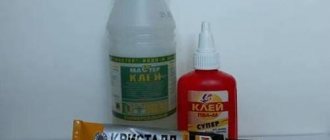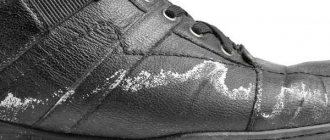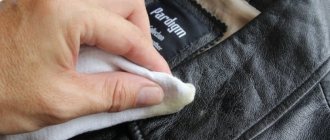Removing all stains, including stains, has its own general rules and sequence that must be followed when working. Otherwise, instead of one spot, several may form. When choosing a stain remover, you need to once again familiarize yourself with the washing and cleaning recommendations given on the product labels. If the chosen product causes concern, you need to test it on an inconspicuous area before cleaning the entire item - on one of the seams or on the inside of the cuff; the inside of the pocket is also suitable. The age of contamination also matters. Stains and stains that appear after an unsuccessful wash or a walk in the rain are often much easier to remove than stains that sometimes form after storing a jacket for the summer.
If stains remain after washing, re-washing the jacket using a vigorous rinse and water-softening conditioners often helps. Particular attention should be paid to proper drying of the product. Jackets are dried flat out away from heaters and direct sunlight; it is best to wrap the washed item in terry towels. They are changed as water is absorbed. If this method fails, hang the jacket on hangers. In this case, to restore its shape, you need to fasten all the fasteners, and about once an hour the jacket is shaken vigorously, holding it by the bottom, which helps to fluff up the filler. This also straightens the product and allows you to avoid ironing after drying.
If repeated washing and drying according to all the rules does not help get rid of the stains, you should use other means. Stains and stains should be removed in good light, preferably during the day. In the process, a board must be applied to the stain from the inside, which is covered in several layers with clean white cotton cloth, gauze or cotton wool. In this case, the lining of the jacket must be trimmed, and the board must be inserted inside, between the lining and the fabric.
For artificial jacket fabrics like acetate silk, acetic acid and other stain removers based on it should not be used as a cleaner, since they dissolve it. To clean such fabrics, you can only use a highly concentrated soap solution. And synthetic jacket fabrics containing nylon or nylon cannot be cleaned with solvents. If stains are removed with a solvent, there is always a risk of creating even worse halos on the fabric, so it is recommended to clean from the wrong side of the material. Remove all stains from the edges to the center, using light rotational movements, until the stain disappears completely. You can use a dropper, brush or cotton swab to touch the clean fabric around the stains as little as possible.
Lemon juice works well to break down many types of stains. It is applied to the stains pointwise and left for half an hour, and then rinsed with water with a small addition of detergent. An excellent remedy is a mixture of peroxide and ammonia in equal quantities. After treating the stains, wait 30-40 minutes and rinse the area with water, repeating the procedure if necessary. Salt solution also helps - 1 tbsp. l. diluted with water to a paste, applied to stains and stains for an hour, then the area is cleaned with a stiff brush and rinsed with water.
Quite often, when washing outerwear using washing powder or low-quality detergent, black or white stains remain on the surface of the fabric - they not only have a very unpleasant appearance, but also negatively affect the quality of the clothing. As a rule, it is possible to remove stains, as well as prevent them - the main thing is to act correctly. It doesn't matter if you don't know how to remove black stains after washing - this guide will help you understand how to get rid of stains after washing.
Common causes of divorce
If streaks appear on the down jacket after washing, it is not at all necessary that the reason is related to the use of washing powder - a black or white coating on the surface of the clothing can also appear for the following reasons:
- Leaving washed items in a damp state for a long time, improper drying of clothes.
- Improper rinsing of clothes, use of poor quality fillers in washed items.
- Incorrect temperature and washing mode in the washing machine, violation of instructions.
Based on this, we can say how to prevent white streaks after washing - do not use washing powders when washing items with fillers, strictly follow the instructions given on the label from the clothing manufacturer, and also set the correct mode, spin, temperature and type of rinse. For types of fabrics that are “prone” to the appearance of black and white stains, it is recommended to use only liquid detergents that are well washed out of the fabric fibers during the spin process.
It's good if you know how to prevent marks from forming on the surface of your filled clothing. What to do if stains have already appeared on the jacket after washing? How to remove stains on a down jacket after washing? Read the manual further, and in a couple of minutes you will know what to do if there are streaks left after washing.
How can you prevent white streaks from appearing?
If a whitish coating forms on things too often, it means that mistakes were made when washing. The following recommendations will help you avoid them:
- choose the right detergent according to the type of fabric;
- carefully observe the dosage of the powder, do not use in excess;
- do not overload the drum with laundry;
- regularly clean the powder tray and drainage system;
- install a water purification filter on the tap or in the car;
- use water softeners with every wash;
- Do not use products containing bleach to wash dark colored items with unstable coloring.
Thus, there are several reasons why white marks may form on clothes. If you avoid them, your homework will be much easier, and your things will always look neat.
A universal way to remove stains
How to remove stains on a jacket after washing if they are yellow or black? You can try using a quality stain remover. You should dilute a small amount of stain remover on the surface of the stain, and then gently rub the stained area with a sponge or soft cloth. Repeat the procedure until the stains slowly disappear. After this, rinse the stained area thoroughly. If the jacket is made of natural down filling, under no circumstances should it be completely wet. How to get rid of stains after washing a down jacket in this case? Only treat stains directly.
How to remove stains on a jacket after washing if stain removers and bleaches, as well as other special products, do not provide the desired result? In this case, there are two options left - stop using clothes (which you don’t always want to do, and not everyone is ready to spend money on a new down jacket), or turn to professional dry cleaning services. Of course, for this you will have to part with a certain amount of money, but this method helps in almost 100% of cases - it’s worth at least trying.
Removing black marks
Not only a whitish coating may appear on washed clothes, but also stains and stains of a different nature. If you don’t want to remove them by rinsing, or the event does not help you cope with the task, you can treat the stains on the down jacket in a localized manner, selecting a suitable product:
- Hydrogen peroxide will help deal with detergent deposits - soak a napkin with the detergent and wipe the desired area with it;
- You can remove a greasy stain using a soda-vinegar mixture - to prepare it, take 1 tbsp of acetic acid, 0.5 tbsp of soda and 500 ml of water; the resulting composition is applied to the contaminated fabric and after 3-5 minutes is washed off under running water;
- You can remove stains from a white jacket with cosmetic wipes, wiping the fabric where necessary, but they should not contain alcohol, otherwise the condition of the product can be significantly worsened;
- if dark stains appear on the jacket, then, in most cases, to eliminate them, it is enough to treat the product with a soap solution - add a little liquid soap to a glass of water, stir, apply the product with a sponge, wipe the stain and rinse with water;
- A detergent designed for washing dishes works well with grease, plaque, and dirt on clothes - the liquid is carefully poured over the stains and after 5-7 minutes they are removed under running water.
If you make some effort, you can cope with such a nuisance, but it is still better to wash your clothes well right away, without streaks or other flaws.
Hydrogen peroxide
How to remove stains on a down jacket? For this purpose, it is recommended to use a high-quality stain remover, selected taking into account the color and quality of the item. To get rid of black spots, you need to apply a certain amount of stain remover to the stains, rub it with a soft sponge, and then wait a little. The procedure must be repeated until the black spots disappear.
Also, a mixture of peroxide and ammonia is effective against dark marks after washing; these substances are mixed in equal proportions. After the paste is ready, rub it into the stains with a cotton pad and leave the item for 30 minutes. You can also use pure peroxide and simply rub it into the stains until they disappear.
Before using stain remover, peroxide and ammonia on a winter jacket, you must check the reaction of the fabric and filler to these chemicals; this must be done on the inconspicuous side. If there is no reaction to the substance, then chemistry can be used to remove stains.
If these methods do not help, then it is better not to experiment further, but simply take the item to the dry cleaner.
How to remove black and white stains from a down jacket?
Are you interested in how to remove stains from a down jacket after washing? There is only one effective option here - it consists of repeated washing, which must be performed according to certain rules. Here are the instructions:
- Remove foreign objects from clothing, turn them inside out, fasten buttons and all zippers.
- Place the down jacket in the drum of the washing machine and throw in a few large tennis balls.
- Set the delicate mode, set the washing temperature to 30 degrees, set three rinses.
- Add a small amount of quality liquid detergent without bleach or stain removers. It is advisable to select products specifically for washing down jackets.
- Wait until the washing and rinsing process is complete; the clothes should be spun gently.
After this procedure, the down jacket will no longer have streaks after washing - using a liquid product and three rinses will allow you to completely remove white and black stains from the fabric fibers. Unfortunately, not every down jacket can be washed in a washing machine - how then can you solve the problem? Here all that remains is to resort to hand washing. It's time to learn how to remove stains from a down jacket after hand washing.
How to avoid powder stains?
It is always easier to prevent a problem than to puzzle over how to solve it later. Therefore, in order to no longer wonder how to remove powder stains from clothes after washing, follow these recommendations:
- Use a smaller dosage of the product - you may be adding too much of it and it is not completely washed out when rinsing.
- Fill the machine drum not completely, but at most ⅔ - this will make it possible to better rinse the item.
- Turn on the extra rinse mode if you are using a machine.
- Rinse 2-3 times in warm water, then a couple of times in cold water if you wash by hand.
- Instead of powder, use liquid products, gels or capsules - they dissolve well at the beginning of the procedure and are washed out faster.
- Wash clothes at temperatures above 30 degrees, as powder granules eat into the fabric to remove dirt and begin to wash out only at this temperature. In this case, of course, take into account the possibility of using a higher temperature, focusing on the composition and quality of the fabric. If only delicate washing is recommended, skip this step.
- Choose the appropriate detergent for washing items based on the type, structure and color of the fabric.
It is easier to prevent a problem than to prevent it. In order not to suffer from removing powder stains, you should adhere to certain washing rules. The following recommendations will help you get rid of persistent problems after washing:
- You can try using a smaller dosage of the product. Most often, stains on clothes after washing appear precisely because of the large amount of powder.
- The washing machine drum should not be filled completely. This will make it possible to rinse things more thoroughly. For maximum effect, it should be filled to approximately two-thirds of the total volume.
- The extra rinse mode will come in handy. It is recommended to use it if you have tried to remove a difficult stain using strong preparations.
- When washing by hand, rinse at least three times in warm water, then repeat the procedure in cold water.
- Instead of powder, you can use capsules, gels or liquid detergents. They dissolve perfectly at the very beginning of the wash and are washed off even during the first rinse.
Should be washed at a temperature of 30 degrees. The granules contained in the powder dissolve only in warm water, first penetrating into the item. If the liquid is not heated to the desired level, you will have to rewash it in order to get rid of powder stains.
The process of contaminating things with washing powder has a fairly simple explanation. Any detergent first penetrates between the threads of the fabric, after which it dissolves and is removed from there. If the powder is of poor quality, it may remain in the structure of the product, thereby creating a stain on it.
Hand wash down jacket to remove white and black stains
So, your down jacket cannot be washed in a machine, so take out a container of sufficient volume and get ready for hand washing, which is safer for the item. It doesn’t matter if you don’t know how to get rid of stains on a down jacket after washing with your hands - the following instructions will help you figure it out:
- Determine what material the filling of your down jacket is made of. If it is synthetic, then the clothes can be washed using the usual method, but they should not be left to soak for a long time, and the water temperature should not exceed 30 degrees. If the filling is made of down, you cannot completely soak such a jacket - you can only wash those areas of the surface that have stains.
- Pour warm water at a suitable temperature into a container (pay attention to the label on the clothing), add a small amount of high-quality detergent and stir it thoroughly.
- Carefully remove stains on the jacket after washing if it is a down jacket made from natural down. Synthetics can be washed more actively. The use of bleaches and stain removers is not recommended.
- Carefully lift the down jacket over the container and wait until the water drains from it. Leave to dry.
Now you know how to remove stains on a jacket after washing by hand washing. In the case of a down jacket made from natural down, it is better to initially use hand washing, since in this case it is much easier to prevent the down from pilling. To prevent this from happening, fluff your jacket during the washing process. So, if your down jacket has stains after washing, you know what to do, all that remains is to understand how to properly dry your clothes.
What is the reason?
It’s not for nothing that baby bubble stains are considered the most difficult to remove. This is not only because they cannot be washed off the first time with ordinary powder, but also because dirt does not always react even to “particularly effective” stain removers. Their peculiarity is that most stains become noticeable after rinsing the item.
It is extremely difficult for a child to protect himself from contamination with soapy water while playing, so many mothers ask a logical question - “how to wash stains from soap bubbles on clothes?”
First, let's find out why the soap stain does not wash off. Many parents and especially grandmothers incorrectly believe that only low-quality Chinese toys leave stains. And they are partly right!
The thing is that the composition of soap bubbles includes: water, sugar, soap solution and glycerin - a viscous transparent substance, which is precisely responsible for the annoying gray stains, which is so difficult to wash off!
Its peculiarity is that when interacting with washing powders and the gelatins found in them, it reacts - hence the stains that appear only after washing.
Therefore, when thinking about how to wash soap bubbles from clothes, first of all you need to understand how to get rid of this harmful component.
How to properly dry a down jacket after removing stains?
Even if there are stains on the down jacket after washing, you can easily remove them, but after washing it is very important to dry the clothes properly, otherwise they may get damaged. It is enough to follow these rules:
- You should not forcefully wring out a down jacket after hand washing; automatic washing should not be accompanied by a high-speed spin - it is better to wait until the water drains by itself, and then dry it.
- The down jacket must be hung horizontally to dry. You should immediately straighten it and give it the necessary shape so that the clothing does not change its shape during the drying process.
- During the drying process, the down jacket must be fluffed regularly, especially if the filling is made of natural down. Otherwise, the filler will crumple and the down jacket will lose its volume.
- In order for the down jacket to dry faster, if stains appear after washing the jacket, you need to hang it outdoors or in a room with good ventilation and open windows.
- You should not place clothes near heating or heating devices - the clothes are guaranteed to deteriorate and lose their shape, and in the worst case, they will be burned.
Sometimes, even after proper drying, unpleasant stains remain on clothes. If there are stains on your jacket after washing, you already know what to do, but what to do after drying? Don't panic - just wipe off the stains with a sponge or cloth soaked in high-quality dishwashing detergent - after this, the stains are guaranteed to disappear, and your clothes will regain their attractive appearance.
You already know how to remove stains on a down jacket after washing, as well as how to properly dry the product so as not to nullify the results of washing. Use the knowledge you have gained and try to prevent the formation of white and black stains on the surface of your favorite clothes in advance - it’s not that difficult!
Stains on glass, linens, furniture, tiles and floors. It seems there is no point in fighting them! But no, in this article you will find secrets with which you can easily and simply say goodbye to divorce forever.
Sweat stains on clothes will become less noticeable or disappear altogether if, before washing, sprinkle baking soda on the stains, moisten with water until a paste forms, rub a little and leave for 1 hour. According to reviews, the “Eared Nanny” stain remover also helps with this problem. Stains on a down jacket appear due to the fact that during washing the down gets into clumps and dries unevenly during drying. To avoid this, wash down jackets with, dry them by laying them horizontally on a terry towel and fluffing them periodically. Soap stains will disappear only if you rinse the down jacket well again and dry it properly. There will be no streaks left on the glass after washing if you wipe the wet glass dry with crumpled newspaper. Stains from special wipes on the monitor can be removed with paper napkins or toilet paper. Stains on a sofa or armchair appear due to the fact that the upholstery of upholstered furniture accumulates dust over time. Trying to remove the stain, you wet it, and when it dries, an unpleasant mark appears. Therefore, before cleaning a mattress or upholstered furniture, vacuum it thoroughly using a small lint-free attachment, or even better, beat it out, covering it with a previously damp sheet. Try diluting ammonia in water and using a spray bottle to apply to the stains. Scrub gently with a suede brush, then use the rubber side of the brush. The process is long and painstaking, but effective. Hydrogen peroxide 3% will help remove stubborn stains. Pour the stain generously, leave it to dry for an hour or two, then dry it with a hairdryer. To ensure that after washing the floor there are no streaks left on the laminate or linoleum, first sweep or vacuum away all dirt and dust. Soak a sponge or rag in a foaming solution and treat the entire floor with it. Now rinse the rag or sponge thoroughly, wring it out and wipe the entire surface to remove any remaining soap. Change the rinse water as often as possible, then there will be no streaks. Stains on tiles are easy to remove if they are cleaned and dried properly. Tiles in the bathroom and kitchen can be washed using one of the following methods:
- foam the dishwashing detergent strongly in water and, having collected the foam with a sponge, apply it to the wall;
- dip a damp sponge in citric acid or soda powder and treat tiles or ceramics with it;
- Spray the surface evenly with vinegar or bleach solution from a spray bottle (if there is mold, this option is preferable).
Leave the cleaner on the tiles for 5 minutes and then rinse it off. If you are sure that there are no chemicals left on the surface, proceed to drying: use a terry, cotton towel or microfiber to wipe the clean wall with rotating movements until it shines.
Salt stains on leather shoes should never be ignored. Rinse contaminated shoes on all sides with warm water. Dry the entire surface with a soft cloth. Inspect the shoes: if there are light stains, treat them with a solution of vinegar and water (1:1) until the stain completely disappears, then dry. An hour after cleaning, apply a protective cream or wax to the product.
Quite often, after washing, you can see unsightly stains on the jacket, spoiling the appearance of the product. Especially often, such stains remain on bulky jackets, for example, on down jackets. However, the situation can be corrected by removing them.
You don't have to take your clothes to the dry cleaner to do this. Most often you can cope with improvised means. You just need to follow some nuances of caring for your outerwear.
Stains on clothes most often appear if poor quality washing powder was used or too much of it was used. Therefore, in order to avoid the very possibility of such stains, you should use specialized shampoos and gels for washing outerwear and follow the recommended dosage. In addition, when washing, you must choose a mode suitable for bomber jackets.
If stains have already appeared, they must be removed immediately, since over time they can worsen under the influence of ultraviolet radiation. There are various recommendations for removing stains using wet wipes or dry cleaning. Unfortunately, these methods do not always help, often only worsening the situation.
In the simplest case (white stains on dark clothes), a second rinse of the clothes in the machine in the double rinse mode will help. To get the best results, do not load more than one item into the drum of the machine.
However, if you need to remove stains from children's down jackets https://adamanto.ru/catalog/puhovik-children/, you can wash and rinse it manually.
The appearance of stains on a light-colored jacket is a more complicated case. Two reasons can contribute to this: the same low-quality washing powder or churning of the filler inside the jacket. If the problem is the powder, the stain must first be wetted with liquid stain remover, allowed to soak in for 10 minutes, and then washed and rinsed twice again.
If the reason for the appearance of stains is the filling being knocked down during washing, you need to carry out the same operations as in the first case and prevent the situation from reoccurring. This can be achieved by placing several tennis balls in the washing machine drum along with the clothes.
However, the case of poor washing of the filler is much more complicated than the situation with low-quality washing powder. Therefore, if you cannot get rid of this kind of stains on your own, it is best to take the item to dry cleaning.
In the future, in order to avoid the reappearance of stains, it is necessary not only to wash clothes correctly, but also to dry them properly. First, the product should be gently spun in the washing machine. Then you need to lay it on a terry towel and roll it into a “roll”, squeezing it well with your hands. All these procedures help to maximize the removal of water from the jacket, which means they minimize the chances of stains appearing on it.
It is recommended to carry out final drying of the product in a place with good air exchange, for example on a balcony. In this case, you should not throw the jacket over a rope or use clothespins. It is best to hang it on hangers. In addition, any bulky outerwear should be dried inside out.
During the entire drying process, you need to periodically beat the product filler. This will ensure it dries evenly.
Author - NATAHART. This is a quote from this post
Upholstered furniture should be regularly and properly cared for. To prevent ingrained dirt, the upholstery should be vacuumed once a week, periodically knocked out with a damp sheet, and removable covers should be machine washed. If stains appear on the upholstery, they should be removed, taking into account the type of stain, as well as the material with which your furniture is covered.
Stains after washing: how to remove?
The appearance of stains on washed clothes is an unpleasant surprise that every housewife has had to deal with at least once. Getting rid of white spots is sometimes more difficult than it seems. They do not go away either after repeated washing or after several rinses.
First of all, it should be noted that this “behavior” is not typical for all types of fabrics and things. Typically, stains appear on outerwear: down jackets, jackets, sports pants, and sometimes on dark blouses and pullovers.
Now you know how to get rid of white streaks on clothes after washing.
How to knock out a sofa yourself?
In order to rid the sofa of dust, you need to knock it out. To work you will need:
- A clean sheet that is no longer used for its intended purpose.
- 2 liters of water.
- 4 tablespoons vinegar.
- 4 tablespoons salt.
Prepare a solution of water, vinegar and salt. Dip a sheet into it, wring it out thoroughly and cover the upholstered furniture with it. Using a beater, start knocking out the dust. This should be done carefully so as not to damage the upholstery. After this treatment, the sheet should be rinsed, wrung out and the knocking procedure performed again. This should be done until the sheet stops absorbing dust. Such cleaning will rid upholstered furniture not only of dust, but also of unpleasant odors.
Regardless of what the sofa or chair is stained with, there are general rules for removing stains that can achieve good results.
- Remove stains as soon as they appear. This rule applies to almost all contaminants (there are some exceptions, which we will discuss below). If you take on the task without waiting for the stain to dry, the likelihood that it will not leave a trace is much higher.
- If you are using a detergent for the first time, first check how it behaves on the upholstery. To do this, choose the most inconspicuous area of furniture. If the color remains the same, you can begin cleaning the stain itself.
- Treat the contaminated area with detergent, working from the periphery to the center. This will prevent the stain from spreading even further.
- You need to rub the fabric in the direction of the grain.
Such pollution is perhaps the most common. In order to get rid of them, you need to immediately prepare a vinegar solution. Pour 2 liters of water into a container, add 2 tablespoons of vinegar and just a little liquid detergent. Take a clean sponge, soak it in the solution and treat the dark spot. Finally, wipe the area with a dry cloth.
If the stain has already dried, then to remove it it is better to use an industrial stain remover suitable specifically for your upholstery. Alternatively, you can call a cleaning service. Craftsmen using professional products will be able to clean furniture efficiently.
If the stain cannot be removed by anything, there is an option to disguise it. This method is suitable for those who are not afraid to experiment. Try painting the upholstery to match the color of the stain, using the same drink that was spilled on the furniture - strong tea or coffee. The procedure is as follows:
- Prepare several liters of the drink and strain it through cheesecloth. For more durable coloring, add 1 teaspoon of salt per 1 liter of liquid.
- Pre-treat an inconspicuous area of furniture with this liquid, for example, on the side facing the wall. If you are completely satisfied with the result, you can begin painting the entire surface.
- Using a sponge, spread the “paint” evenly over the entire upholstery. You can even apply coloring liquid through a stencil to create a pattern. Keep in mind that in areas where the upholstery is thicker (seam areas), the color may turn out darker. If you do not want to get a similar effect, you should not apply too much tea leaves to them.
- Wait until the furniture is completely dry.
If a grease stain is detected, it must be immediately covered with salt for several hours (it will act as a sorbent). The sofa can then be vacuumed and the stain treated with a commercial stain remover (such as Vanish).
If the upholstery of your upholstered furniture is made of fleecy fabric, the greasy stain can be removed using sawdust soaked in purified gasoline. Place them on the problem area, and after two hours, sweep them away with a brush.
A rather risky way to deal with grease on furniture upholstery using a hot iron and paper placed on the stain. Through such a gasket, the contaminated area simply needs to be ironed. This method may help, but if the iron is too hot, the grease may become even more embedded in the fibers.
Remove whiteness from black jeans
How to remove bleach stains from your favorite jeans or a black T-shirt?
Information. Stains from strong cleaning products appear instantly. The black clothes are turning red in places, and it seems that nothing more can be done to help her. The problem is that bleach completely changes not only the color, but also the structure and composition of the fabric.
Do you want to remove a whitish stain from a sweater that is so irritating to your eyes? Have bleach stains ruined your new item? You were cleaning and accidentally spilled Domestos on your clothes?
The first tip that comes to mind in response to the question of how to remove a white stain from black things is to paint them. You can do this by visiting a craft store and purchasing specially designed dyes there.
It is very important to strictly follow the conditions described in the instructions, because dyes exist for different types of fabrics.
Sometimes you need to paint at a temperature of forty degrees, sometimes seventy.
In order to color the product evenly and not spoil it, you can wash it in a washing machine using dyes.
Among other things, you can resort to the following method:
- Dissolve one teaspoon of sodium thiosulfate in a glass of warm water;
- Carefully treat the affected area;
- Leave for a while and then wash as usual.
If the stain remains on the surface of the fabric for more than three days, you can try to remove it with acetylsalicylic acid:
- You need to crush 2 aspirin tablets and mix them with warm water. You cannot stop stirring, since aspirin in the form of regular aspirin tablets is slightly soluble in water;
- Next, we apply this paste to the affected area and leave it under pressure for two to three hours. Well, then, of course, we wash the item with powder.
To remove stains from fabrics of natural origin, for example silk, linen or cotton, use ammonia:
- In one glass of warm water, dilute one teaspoon of ammonia and the same amount of salt;
- Soak damaged clothes in the solution for 30-60 minutes;
- Wash clothes using laundry soap.
Another method that is only suitable if you plan to remove bleach stains from jeans.
The method is old, but quite effective.
To implement it, we will need 10 liters of water, one and a half glasses of white (approximately 250 ml).
This is interesting: To make suede shoes pleasing to the eye, how to remove or remove stains from grease, salt, glue
Boil water to which whiteness has previously been added. While the water is boiling, tightly twist the gins.
When the water boils, drop tightly rolled jeans into it and boil for about thirty minutes.
After cooking, quickly rinse the jeans in cold running water. Let's enjoy our new jeans, because no one will think that just yesterday these fashionable jeans were part of the home wardrobe and were worn exclusively while cleaning.
We remove stains from fruit and vegetable juices.
Such contaminants can be dealt with using the folk method. To do this, you need to mix ammonia and vinegar (in proportions 1:1), moisten the stain with the resulting solution and leave to dry. Once the upholstery is dry, the area to be treated should be rinsed with clean water and then dried with a hairdryer. If you have an industrial stain remover at home that can deal with organic stains, you can use it.
It is best to remove animal marks with special preparations that are sold in pet stores. They are made on the basis of enzymes and cope best with such contaminants. These products come in powder, liquid or aerosol form. “Zoovorsin”, “OdorGone” or “Pet Stain&Odor” are suitable for cleaning upholstery. They cope with traces of pet excrement, get rid of unpleasant odors and, in addition, destroy various microbes. These products can be used to effectively clean cat litter boxes.
Creative activities with children often result in stains on various surfaces. It’s not so difficult to deal with a blot on a table, but to clean it from a sofa or chair, you will have to try hard. The most important thing when cleaning like this is to take into account the type of paint that got on the upholstery.
oil paint stains from upholstery
, you need to use a special solvent designed for cleaning fabric. If you don’t have one at hand, take butter instead, treat the stain with it, and then wash it with laundry soap.
watercolor stain
It's not too difficult to remove. This is a water-soluble paint and can be easily washed with ordinary laundry soap. But it’s almost impossible to deal with a dried stain. So don’t delay cleaning if you want to restore the neat appearance of your sofa.
gouache stains
, do not use hot water under any circumstances. This paint is made on an adhesive basis and this treatment will further fix it in the fibers of the fabric. Laundry soap can handle a fresh stain. If the paint has already dried, you must first scrape off the top layer, and then work the remaining mark with soapy water using a stiff brush. If this method doesn't work, try cleaning the upholstery with acetone or rubbing alcohol.
Get rid of after washing
If, after washing, your favorite wardrobe item does not get the desired appearance, and is full of stains from powder, detergent, or whiteness, we recommend resorting to the following, no less original methods.
Method No. 1
If a small, barely noticeable stain appears on your favorite T-shirt, but its very appearance causes negative emotions, inspect the item and evaluate the color. Select a felt-tip pen or marker to match the color of the damaged item and carefully, pointwise, paint over the area affected by bleach. After light “makeup”, iron the affected area through a piece of cloth so that the excess dye is absorbed into it.
This is interesting: How to choose the best quality jeans
Method No. 2
This method is more suitable for youth T-shirts, which, even at the production stage, are painted with all sorts of colors, deliberately creating stains and streaks.
To carry out this kind of resuscitation efficiently, you will need fabric paint.
In any sewing store you can find all kinds of colors and shades.
Natural fabrics lend themselves best to resuscitation in this way.
Method No. 3
This method is only slightly different from the previous one: to perform it correctly, you will have to go to a fabric store or a nail store and buy acrylic paint in tubes (which is important).
The viscous consistency of this type of paint will allow you to independently draw an applique, a pattern that will cover up, and maybe even organically play up the stain from the cleaning agent.
After the acrylic paint has completely dried on the product, you need to take a piece of cloth, cover the painted area and iron it. Once heated, the acrylic paint will firmly adhere to dense fabric and the pattern you apply yourself will delight you for a long time!
This method is suitable for all types of tissue, but it is best to carry out such resuscitation on rough tissues.
Method No. 4
Suitable for creative people who know how to embroider with thread or ribbons. It’s very beautiful when a bleach stain on a blouse is skillfully hidden under neat embroidery, especially considering that in recent years embroidery has remained quite a fashionable and stylish wardrobe detail. Perhaps a speck of bleach or Domestos will encourage you to create an incredibly fashionable masterpiece?
Method No. 5
This is the easiest and fastest method and is suitable for almost all types of fabrics that can be heated. In order to save your item, you just need to buy a patch at any hardware store. Then, at home, you smooth out the damaged item, put the patch you like on it and iron it thoroughly. Fast and convenient!
We remove stains from cosmetics.
To remove such stains, you need to prepare an alcohol solution - stir 2 tablespoons of alcohol in half a glass of water. Soak a sponge in this product and remove makeup from the upholstery.
Blood is not easy to clean. Please note that hot water should not be used when treating such stains. Several methods are suitable for removing this type of contaminant:
- Use a commercial stain remover that is suitable for your upholstery and can handle blood stains.
- If the stain is completely fresh, wash it with laundry soap. Take a sponge, dip it in cold water and wet the stain. Then rub it with a bar of soap or shampoo. After a few minutes, rinse off any remaining product with clean water and a sponge.
If the furniture is light in color, you can prepare a saline solution (dissolve half a tablespoon of salt in 500 grams of water). The stain is treated with this product twice with a break of 1 hour.
How to clean leather furniture from various contaminants?
Furniture upholstered in leather can most often be found in offices. The most common stains here are stains from drinks and ballpoint pens. It is not too difficult to remove them from leather surfaces.
There will be no trace of hot coffee left if you immediately blot it with napkins and then wipe with a clean damp cloth.
Fresh marks from a ballpoint pen can be erased with a cotton pad soaked in alcohol. If the ink has already dried, then you need to prepare a mixture of salt (1 tablespoon), dishwashing liquid (2 - 3 drops) and water (1 - 2 tablespoons). Apply the mixture to the stain and leave for 5 hours. Then sweep away the remaining product with a brush and wipe with a damp cloth. To prevent the leather from cracking, after such treatment it should be moistened with oil.
Ink stains on light-colored leather can be removed with glycerin. It is used both solo and in tandem with ammonia (1:1). Apply it to the dirty area, and after a few minutes wipe it off with a sponge. For dark skin it is better not to use this method, as glycerin can leave a whitish residue.
Features of caring for white leather furniture.
White leather furniture needs to be looked after very carefully so that it does not lose its attractive appearance.
- Cow's milk is perfect for such furniture. It can restore the whiteness of the leather surface. Just soak a cloth in milk and wipe the entire surface of the furniture.
- Ammonia will help remove a variety of contaminants from white skin. Along with alcohol, non-concentrated vinegar can also be used to combat stains. Most importantly, do not forget to moisturize the leather surfaces after such treatment. To do this, you can use glycerin or vegetable oil (sunflower, castor or flaxseed). This is necessary to prevent cracks from appearing on the skin.
- In hardware stores you can find various products specifically designed for caring for leather furniture (“Dual Power”, “Motul M3 Perfect Leather”, “Doctor Wax” and others). You can also purchase special wipes (for example, Leather Wipes or Starwax). With regular use, your furniture will look like new. Such products are not very cheap, but they are very effective.
Flock -
This is a very durable material on a cotton base with nylon pile. It is able to repel dirt. It does not shed when wet cleaned using chemicals.
Velours
Can be cleaned wet. For such material, a weak solution of vinegar (one teaspoon dissolved in a liter of water) is best suited. Soak a cloth in the product and wipe the stain.
Suede -
very delicate material. Such furniture should be handled very carefully and water should not be allowed to get on the upholstery. For suede, dry clean only. It is carried out using a special brush with rubber bristles. To remove complex stains, it is better to call a cleaning service.
Plush or velvet -
not the easiest materials to care for. They require delicate handling. Too hard brushes are not suitable for cleaning them. Furniture with such upholstery is removed from dust using a vacuum cleaner. First, cover the sofa with an old sheet and treat the surface through it. After this, remove the sheet and lightly wipe the upholstery with a damp cloth. If a greasy stain appears on a plush or velvet surface, it can be removed with gasoline.
Microfiber
It can be easily washed off from almost any dirt using a sponge and laundry soap. But you need to keep in mind that this material is not very wear-resistant. It should not be subjected to strong friction. When cleaning, do not use hard brushes.
Tapestry -
very durable, dense material, quite wear-resistant. But it is better to clean it in a dry way, since the tapestry does not like water too much; it can shrink from excessive moisture. The best way to clean it is to knock it out through a damp sheet. If this method does not help get rid of spot stains, you can remove them using “Vanish” for carpets. Whip the product into a stiff foam and apply it to the upholstery with a brush. This should be done carefully so as not to wet the fabric too much. Wait until the foam dries and vacuum it up.
Try to prevent stains from appearing on your upholstered furniture by cleaning it using a vacuum cleaner and beating. By regularly removing dust, you will not only keep the upholstery in good condition, but also take care of your health.
Stain on fabric
Water stains that appear on clothes cause no less trouble.
Removing stains from drape.
If a rainwater stain appears on the drape, you need to dry the clothes and clean the stain with a thick, stiff brush. Afterwards, you need to shake the product thoroughly and thoroughly steam it through a soft linen cloth soaked in a weak solution of vinegar (1 teaspoon 1 liter of water).
After boiling the coat (or other clothes made from drape), hang it on hangers, but do not put it in the wardrobe, let it cool and dry at room temperature, then it will not lose its shine and presentation.
Removing stains from silk.
On silk fabrics, water leaves unsightly grayish-white stains. They are removed as follows: wipe with a soft linen cloth soaked in strongly salted water (1 teaspoon per 1 glass of water at room temperature). Allow the stain to dry, then use a soft, dry linen cloth to remove the white coating along with traces of water stains.
Removing stains from cotton and linen.
Water leaves nasty yellow marks on cotton and linen fabrics that are very difficult to remove. Remember: bleaches that contain chlorine are not suitable for such materials, because it will thin their surface and give them a dirty yellow tint.
